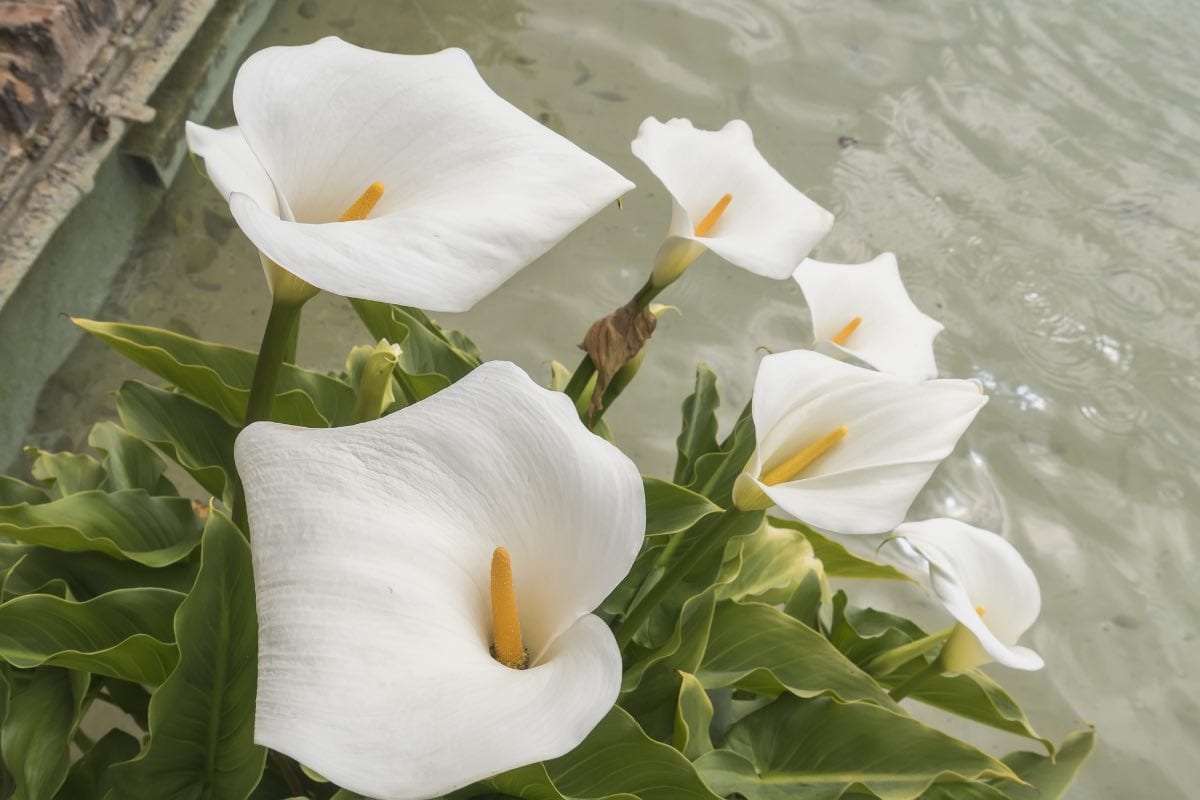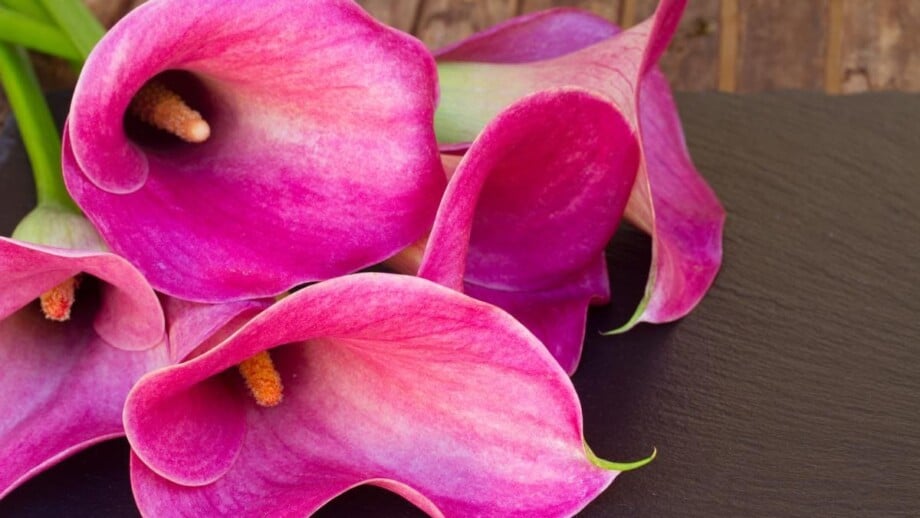Calla lilies are admired for their understated elegance. They have long been a popular choice for Easter bouquets and are frequently included in a variety of flower arrangements for events like weddings and funerals. Calla lilies symbolize purity, rebirth, and resurrection with their pure-white trumpet-shaped flowers and delicate appearance.
These perennials can be grown in pots, flower beds, and along borders, where they can reach a height of 1-3 feet.
Here’s a complete guide on how to grow and care for your Calla lily plant so it’ll thrive in your garden.
Botanical Name: Zantedeschia aethiopica
Common Name: Calla lily, arum lily
Family: Araceae
Plant Type: Rhizome
Hardiness Zones: 8 to 10 USDA
Sun Exposure: Full, partial
Soil Type: Moist but well-drained
Soil pH: Acidic
Height: 2–3 ft. tall
Bloom Time: Spring
Flower Colors: White, coral, pink, maroon, yellow, and orange
Native Area: Africa (Southern Africa, Swaziland)
What is a Calla Lily?
Ironically, Calla lily flowers are not considered ‘true lilies. Calla lilies grow from rhizomes and come in bright white and different shades of deep pink, rose, bright yellow, orange, and dark maroon or burgundy. Some have pretty white freckles on their leaves, so they are eye-catching even when not in bloom. Calla lilies, or arum lilies, are native to South Africa. Their distinctive shape makes them stand out in garden beds; Calla lilies also make for great indoor houseplants.
Calla lilies, or arum lilies, are native to South Africa. Their distinctive shape makes them stand out in garden beds; Calla lilies also make for great indoor houseplants.

Calla Lily Care
Growing and caring for Calla lilies is easy as they do not need too much attention.
Although, location and proper planting are essential factors to keep in mind while growing this plant. Care for the Calla lily requires planting them in loose and well-drained soil and ensuring they’ll receive full sun or partial shade in warmer climates.
These lily plants are recommended to be planted in spring. However, if there’s a threat of frost, you should wait until it passes and the soil is warmed sufficiently before planting Calla lilies.
Light
These lilies are tropical plants that thrive in warm environments and conditions, including plenty of bright, indirect light.
Your Calla lilies can handle full sun or partial shade in warm climates.
Water
Once the plant’s rhizomes are well established, you can water it once a week or more if your region is experiencing drought-like conditions. Indoor Calla lilies need constant moisture, as pots will dry out quicker than ground plantings.
Humidity
These lilies enjoy high humidity and moisture levels, so humid summers keep this flower blooming just fine.
Avoid humidity percentages below 50 and considerable fluctuations during daytime humidity. Cala lilies thrive beautifully when cultivation variables are kept constant.
Temperature
Calla lily flowers are fans of warm temperatures and environments between 60°F-80°F. When temperatures drop below 50°F, the plants go into dormancy.
Dig up your plant’s rhizomes for overwatering before freezing temperatures occur.
Frost can kill your Calla lily.
Soil
A moist, rich, well-drained soil is best to keep Calla lilies plants blooming.
These plants grow well alongside ponds and can tolerate a moist soil location. However, avoid allowing Calla lilies to become waterlogged, as it can lead to root rot. To increase your plant’s nutritional density of your soil, feed it with organic matter before planting your lilies.
Fertilizer
These lilies need feeding upon planting and at the beginning of every spring growing season to promote stunning flowers.
Well-balanced fertilizers should work fine. Do not use a nitrogen-heavy blend, which can reduce the plant’s flowering.

Calla Lily Propagation
These lilies can be easily propagated by dividing their rhizome.
Calla lilies form large clumps, which can be divided into individual plants.
Plants that grow from rhizomes will bloom much sooner than seed-grown plants.
To divide a Calla lily rhizome, follow these steps:
- Use a shovel to pull up the rhizome if your lily is in the ground. You’ll need a clean pot and potting soil to keep your new plant indoors.
- Use a shovel to cut a circle around the root to make it easier to pull.
- Once the clumped root has been pulled up, brush off the dirt and place it in a well-ventilated, shady, dry place until it dries out. Do not water it.
- Once the rhizome has dried out, use a sharp, clean knife to separate the rhizomes, ensuring that each piece has at least one eye or root growing from it.
- Replant the rhizome in a potting containing moist, well-draining soil or in a compost-enriched garden bed leaving at least six inches from other plants.

Calla Lily’s Common Problems
When growing these lilies, you may encounter several issues, most notably bacterial soft rot, which affects the botrytis and rhizomes, a fungal disease that creates a filmy grey mold that grows over the plant’s leaves, stems, and petals.
To reduce fungal disease risks, do not overwater your lily, and make sure to plant each Calla lily far enough apart, so it has ample air circulation.
Common pests
Various pests can infest Calla lilies, including slugs, spider mites, and aphids.
You can treat your plants with horticultural oil like neem oil or mild insecticidal soap to combat any of these pests.
Yellow leaves
Calla lilies love water. They may not bloom and turn yellow if they don’t get sufficient water.
Also, a sign of underwatering is stunted growth and wilting. To keep your plant’s foliage healthy, water it consistently.
Brown edges
If you notice your plant’s leaves’ edges turn brown, it may be because you are using nitrogen fertilizer. The best you can do is get a new fertilizer.
Calla Lily Toxicity
Like other Aracear family plants, Calla lily plants contain insoluble calcium oxalate that punctures sensitive tissues of the gastrointestinal system.
When eaten, they can cause irritation of the IG tract, pain, temporary hoarseness, difficulty swallowing, and swelling to both humans and pets.
Though Calla lily poisoning is rare, any part of the plant will almost certainly result in a rather unpleasant experience if ingested.
Also, if the plant’s juices come in contact with the skin, swelling, pain, or burning may occur.
Contact a medical professional or poison control if any adverse reactions occur.
Other Flower Guides from Planet Natural:
How to Plant, Grow, and Care for Lily Flowers at Home
How to Plant, Grow, and Care for Shampoo Ginger Lily











